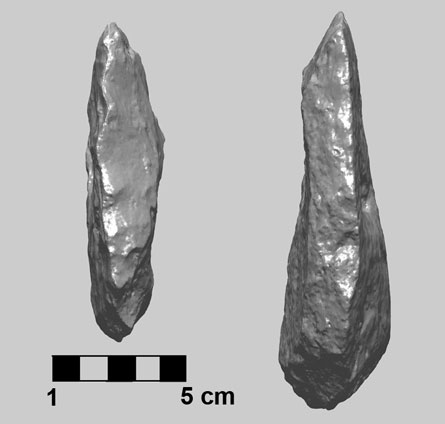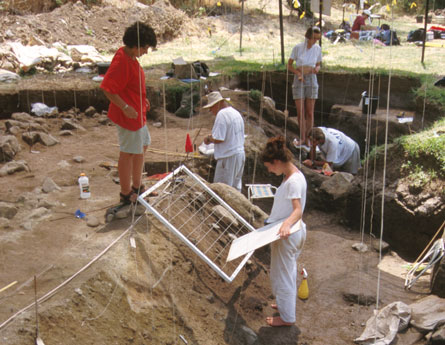Stone Age campers set up separate activity areas
Hominids displayed advanced organizational thinking almost 800,000 years ago
Stone Age members of the human evolutionary family took organization to heart — and to hearth. Nearly 800,000 years ago, inhabitants of a campsite in what’s now northern Israel conducted different activities in different parts of their living space, much as hunter-gatherers do today, says a team led by archaeologist Naama Goren-Inbar of Hebrew University of Jerusalem.


Organizational and planning skills usually attributed solely to modern humans emerged considerably earlier than scientists have assumed, Goren-Inbar and her colleagues propose in the Dec. 18 Science.
The team mapped the distribution of a wide array of remains preserved at the ancient site of Gesher Benot Ya’aqov, or GBY. Two main clumps of remains materialized. The campsite’s northwestern portion contained evidence of flint-tool production and fish preparation. Near the remains of a hearth in the campsite’s southeastern section lay debris from tool resharpening, implements made from basalt and limestone, fish bones, crab pincers, and stones bearing signature pounding marks produced during nut cracking.
Daily behaviors occurred in two main parts of a rectangular living area excavated at GBY, the researchers conclude. One area hosted primarily flint-tool making and preparation of fish for eating. In another area, situated around a large hearth, residents resharpened used stone tools, fashioned new tools out of basalt and limestone, ate fish and crabs, and cracked nuts after roasting them.
Roasting allowed the inedible shells of various nuts to be easily peeled off. It also reduced levels of bitter substances, called tannins, found in acorns.
“Hominids who were responsible for the organization of space at GBY had very advanced cognitive abilities that have generally been considered an important marker of human intelligence,” Goren-Inbar says.
Many researchers have thought that the mental capacity to plan and organize living spaces around different activity areas first arose among Homo sapiens roughly 100,000 years ago, well after the species originated around 200,000 years ago.
Until now, hominid sites from before 100,000 years ago had yielded stone tools and bones of various animals but no signs of separate activity spots in common living spaces.
No hominid fossils have been found at the Israeli site. Candidate species that could have lived there include Homo erectus, Homo heidelbergensis or a predecessor of Neandertals that later lived in the vicinity, according to Goren-Inbar.
“As far as I know, this is the earliest evidence for the designation of different activity areas and is very early evidence for advanced organizational skills,” remarks archaeologist Lyn Wadley of the University of the Witwatersrand in Johannesburg.
Waterlogged sediment at GBY preserved artifacts much better than dry soil at other hominid sites of comparable age, notes archaeologist Curtis Marean of Arizona State University in Tempe. “This one data point provides intriguing evidence that the foundations for cooperative group living may have been set well before the origins of the modern human lineage,” Marean says.
GBY stretches for about 6.5 kilometers along the Jordan River. Earlier excavations led by Goren-Inbar indicated that hominids established a series of campsites at GBY, at the edge of what was once a lake, between 790,000 and 690,000 years ago. Sediment rapidly covered each campsite once it was abandoned, preserving artifacts in their original locations.
Ancient campers at GBY apparently used stone hammers and anvils to smash open almonds and other hard-shelled nuts (SN: 2/23/02, p. 117). Burned seeds, wood fragments and pieces of flint near the remains of hearths reflect controlled fire use at GBY (SN: 5/1/04, p. 276).
Goren-Inbar suspects that individuals of both sexes and all ages participated in activities at this campsite. In modern hunter-gatherer groups, women, children and older persons gather nuts and ready them for consumption. Men concentrate on making tools for hunting and butchering game.
It’s hard to know whether GBY hominids formulated social rules about who performed what activities in which areas, as hunter-gatherers do, Wadley says. Hunter-gatherers also divide up activity areas based on kinship, gender, age, status and skill. These types of social partitions are tough to identify at ancient archaeological sites.
Still, two groups apparently performed related activities about 10 meters apart at this particular GBY campsite, Wadley says. “One might have expected that the whole group would sit around one fire,” she comments. “This kind of separation of people is indeed the sort of behavior that is found in modern campsites.”






